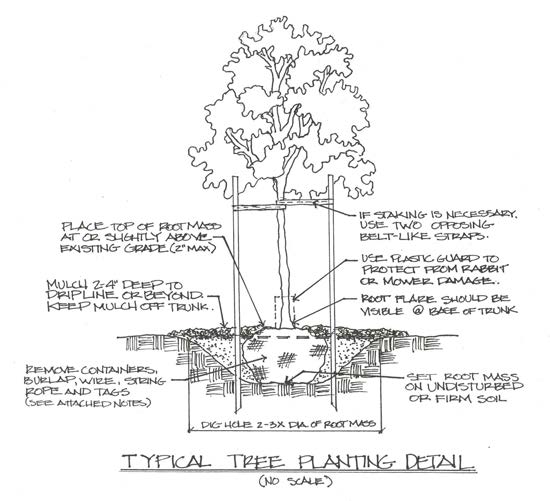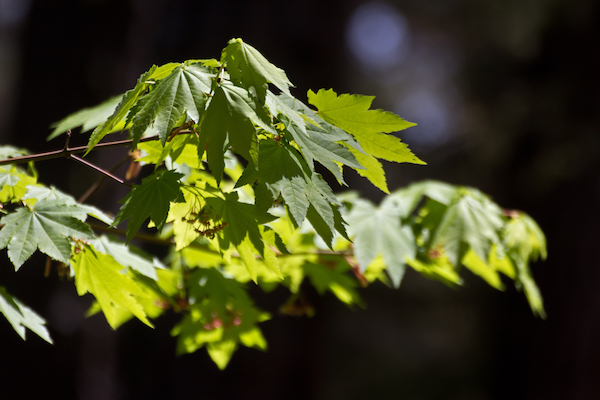
As spring arrives, the planting season gets underway. When planting trees and shrubs, spring is the second best time of year; second only to fall, with it’s long period of moderate temperatures allowing more time for root development before the plant is tested by a hot Nebraska summer. Gardeners wanting to plant trees and shrubs this spring, have a window of time from approximately April 1st through June 30th when soil is workable and temperatures are favorable for new plant establishment. Avoid planting trees and shrubs in the middle of summer, July 1st though August 30th, when conditions are very hot and dry.
Bare Root Plants
Bare root plants, such as fruit trees, small fruits and roses, are normally planted earliest in the spring while they are still in a dormant state and before their buds begin to swell. Ideally bare root plants should be planted the same day they arrive, however, this is not always possible and your plants may need to be stored until planting conditions improve. Careful handling before planting occurs will determine success or failure. Bare root plants have had the soil washed or shaken from their roots after digging from the field. Because bare root plants lack a rooting media that supplies water to the plant, they must be stored in a dormant state with temperatures slightly above or below freezing, and high (95%) humidity levels. However, do not allow them to freeze.
When bare root plants are shipped from a nursery their roots are usually wrapped in damp sphagnum moss or newspaper. The plants are then placed in a plastic bag and packaged in a wax-coated or cardboard box. After receiving the plants, inspect them briefly to ensure they are healthy and undamaged, and that the packing material is still moist. Re-wet the packing material if necessary, and then store the plants in their packaged state, under cold temperatures until they can be planted. It is helpful to re-hydrate the plants by soaking them in a bucket of water for a couple hours right before planting, however, DO NOT store the plants with their roots in water overnight.
Container Plants
Container plants have a longer window of time when they can be successfully planted, from approximately late April through the end of June. Be careful with plants that have been protected in a greenhouse, when planting them outside before the last spring frost date. You may need to provide protection if heavy frost is predicted to avoid leaf damage. To minimize stress on the plants, try to plant on a calm or cloudy day, and keep the plants moist during the planting process.
Planting Techniques
With wood plants like trees and shrubs, it is best to plant them directly into the native soil, without adding any soil amendments. New roots will tend to stay within the area of amended soil instead of spreading out and providing good support for the tree, so eliminating soil amendments actually results in a more extensive root system.
When planting any tree or shrub, one of the most important considerations is making sure it is planted at the correct depth. Roots need oxygen from soil to properly grow. If a plant is planted too deep, the root system doesn't develop as well because it doesn't receive enough oxygen. As a result, the plant can be stunted, have low vigor, and be more susceptible to insects and diseases throughout it’s life.
To determine the proper planting depth, find the first main root at the top of the root system and plant it just below the soil surface. If the plant is in a container, remove it from the container, then pull the soil away from the top of the rootball until the first root or the “root flare” is located. The root flare can be found on all trees at the base of the trunk where the trunk widens before differentiating into the root system. When planted properly, the tree’s root flare should be visible at the soil surface after planting.
When ready to plant, don't dig the hole any deeper or loosen the soil at the bottom of the planting hole any more than necessary. If the soil is too loose, it will settle after the plant has been in the ground for a while, causing the plant to sink. Dig a shallow, wide hole and loosened soil around the sides. Roughing up the edges of the hole will avoid “glazing” from the back of the shovel that can make it difficult for the root to penetrate through the soil as the tree begins to grow.
Remove any burlap, ropes, strapping materials, plastic containers, wire baskets, plant tags or any other type of labeling attached to the plant before putting the plant in the planting hole. Once the proper planting depth has been checked, backfill with soil, gently firming the soil around the base of the roots. When the hole is filled, apply water and soak the planting hole, allowing the water to eliminate any remaining air pockets. Finally, apply a two to three inch layer of organic mulch, such as wood chips.
Staking trees is not recommended unless the plant is in a very high wind location. Also, don't fertilize new trees and plants for the first two to three years after planting. The same goes for pruning and shaping; limit pruning to broken branches only during the first few years.

